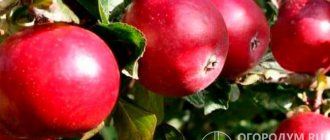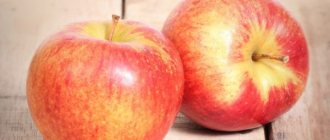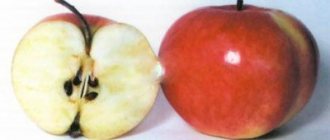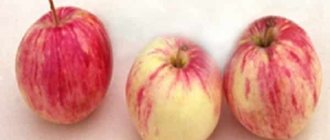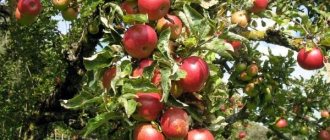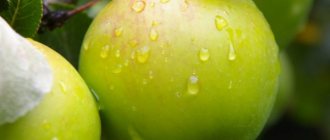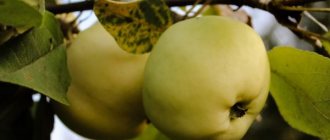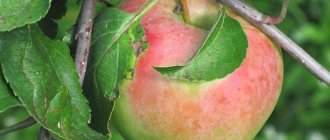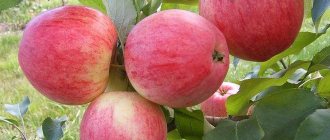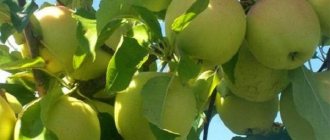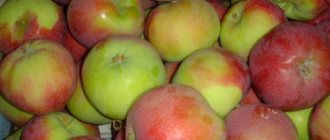The Pupilnitsa apple tree variety is rightfully considered one of the most beloved semi-cultures among gardeners in Siberia. In harsh climatic conditions, seedlings of the variety grow and bear fruit remarkably well. Many people do not want to grow fruit trees, considering this to be labor-intensive, troublesome and expensive. Those who took the risk and planted the Pupilnitsa apple tree on their plot annually reap a bountiful harvest of tasty and aromatic apples.
Description of the variety
The semi-cultivated apple tree Pupilnitsa was obtained by crossing the Pudovshchina and Aporta varieties. This is the name given to the result of crossing large-fruited trees with ranetki. It grows up to 10 meters in height and has a compact rounded crown. The apples are small, but very tasty and healthy.
Advantages and disadvantages
Like any variety there are pros and cons. Gardeners note the following features of this hybrid:
- high frost resistance;
- productivity;
- taste qualities of fruits;
- medicinal properties of apples.
Disadvantages of this tree:
- weak resistance to fungal diseases;
- fruiting for 5-6 years;
Preventive treatments and timely detection and treatment of the apple tree will make the deficiencies less obvious. The late start of fruiting will be covered by large harvests of tasty and healthy fruits.
Description of the tree
The apple tree is tall, grows quickly, and by the age of 10 it can grow up to ten meters in height. On fertile soils, the annual growth is 100 cm. After fruiting begins, the growth of the tree slows down.
Productivity and frequency
Pupil is a high-yielding variety; 40 kg of apples are harvested from one tree, but often 80 kg of apples are collected.
With regular care, the tree bears fruit annually and abundantly.
Description of fruits
Fruits of the variety Pupil.
The apples are round, slightly flattened, one-dimensional, weighing 20-30 grams, which depends on the region of cultivation, scion and care. Some fruits reach 100 grams.
The skin is greenish-yellow in color with a crimson-red blurry blush on most of the fruit and a large number of white subcutaneous dots. The pulp is greenish, juicy, sweet, with carmine veins.
Tasting assessment
Tasters rated the wine-sweet dessert taste of apples at 4.5-4.8 points out of 5. This is a high rating for summer-ripening varieties.
Winter hardiness
The variety is considered winter-hardy, but in some years, at critical sub-zero temperatures, freezing of young shoots was noticed. In especially cold regions, it will be necessary to take care of preparing the tree trunk for the cold and insulating the trunk.
Disease resistance
The tree may be affected by scab, the fruits and leaves are moderately affected. To preserve the harvest, preventive treatments should not be neglected.
Spraying an apple tree against pests.
Apple Tree Kindergarten
Early autumn term, 60 g, dark red, sweet with a dessert wine tint
Description of the variety:
Early autumn ripening period - harvesting in early to mid-September. Semi-cultivated. Fruits 60 g, beautiful, smooth, solid crimson, flattened, greenish flesh, with a dessert wine-sweet taste. Transportability is good. The variety is intended for both fresh consumption and processing. The variety is self-sterile and begins to bear fruit in 4-5 years. Frost-resistant, very productive - produces up to 40-60 kg of apples per tree, the fruits are stored for 2 months. The tree is vigorous, with a rounded crown.
How to buy apple tree seedlings Pupil at the Siberian Garden nursery
In our nursery, you can buy seedlings of the Pupilnitsa apple tree on open trading floors and in nursery stores. For addresses, opening hours, and phone numbers of retail outlets, see the “Contacts” section (in the top menu).
The Siberian Garden nursery delivers seedlings throughout Russia. You can order plants in our online store at: zakaz.sibsad-pitomnik.ru or follow the link in the top menu. You will also find information about the conditions for placing orders, paying for them and delivering seedlings throughout Russia in the online store in the relevant sections.
The Siberian Garden nursery sells seedlings wholesale and invites organizations involved in the sale of seedlings, landscape design, as well as organizers of joint purchases, to cooperate. The terms of cooperation can be found in the “Wholesalers” section (in the top menu).
sibsad-pitomnik.ru
Features of ripening and fruiting
The ripening time and taste of the fruit depends on the region of planting, weather conditions and care.
Start
The late summer apple tree Pupilnitsa begins to bear fruit 5-6 years after planting. Apples appear on annual side shoots.
Flowering time
The tree blooms in the third decade of May. But depending on the weather conditions during this period, the flowers may bloom in early June.
Fruit ripening
The fruits ripen in early September. They become dark burgundy with white subcutaneous dots.
Fruit storage
After picking, apples are stored for 2-2.5 months, which is very good for a summer variety. But their purpose is universal; often the fruits are processed.
Plum-leaved apple tree, or Chinese apple tree
Prunum apple tree, or Chinese apple tree, is a type of apple tree with small fruits. It is often also called the apple tree of paradise (paradise). In fact, the apple tree of paradise exists as a subspecies of the low apple tree and is characterized by low growth. But people don’t care what the correct name for a Chinese woman is. The speech patterns that have developed among the people exist and will exist regardless of anything. All the same, the Chinese fruits were and will be called apples of paradise. Moreover, in culinary literature, Chinese apple jam is often called jam from heavenly apples. Chinese plum leaf is called for the similarity of its leaves to plum leaves. In the wild, this apple tree is distributed in a number of provinces of China. In Russia, it is cultivated in the northern fruit growing regions, in the Central region, the Volga region, Siberia, the Urals and the Far East. The undeniable value of Chinese plants is their frost and winter hardiness. But even more valuable is that you can make jam from these apples, using them whole, including the tail. And the very sight of the abundance of these apples on the tree, and their taste, as well as the look and taste of the jam made from them - all this is a fascinating sight, usually causing delight and pleasure from what is seen and tasted. As a rule, there are no indifferent people.
Now many gardeners have begun to understand that without Chinese gardening the garden will be incomplete. Recently, the popularity of Chinese apple trees has increased. The Chinese variety called Long (Dolgo, Long) is especially well known and in demand. This old variety is a hybrid of the Siberian apple tree with an unknown cultivar. The seeds of the Siberian apple tree were exported from Siberia by the American N.E. Hansen back in 1897. The variety was introduced into cultivation in the USA in 1917. The name of the variety is associated with the elongated shape of the fruit. These bright red apples weighing 20-25 g ripen in enormous quantities at the end of summer. The branches are simply covered with the harvest. The apple pulp is creamy with red veins, dense, with a strong aroma, very juicy. The taste is wine-sweet and pleasant.
Photo: Sort Long
There is also a Chinese variety of Sverdlovsk selection called Pupil. Ruddy, with white, juicy, sweet flesh, apples weighing 20-25 grams ripen in early September, simply amazing everyone with their abundance. It was the Pupil, along with some other varieties, that was once used in the clinic to confirm the possibility of treating hypertension with the help of apples, due to the high content of flavonoids (vitamin P) in this variety. The pupil also belongs to the plum-leaved apple trees.
And about one more variety. Several years ago I found an apple tree of the same species on a slope. Its fruits could not leave me indifferent. At the end of August, I brought home half a bucket of white, sweet, plump apples weighing 20-25 grams each and showed them to one of my friends. This woman immediately dubbed them apples of paradise and wanted to make jam from them. I had to give her the apples. Then I grafted this variety and grew several trees. They began to bear fruit already in the third, and some even in the second year. By the way, many of the existing varieties of fruit and berry crops were once found somewhere by someone. For example, the most famous varieties of apple trees in Russia, such as Papirovka (White filling), Anisaly and Anis striped, Grushovka Moskovskaya, Antonovka ordinary, Cinnamon striped, are actually folk varieties and were once found and distributed by our ancestors. Not only that, as Professor V.L. says. Vitkovsky in his book “Fruit Plants of the World”, “... many of the varieties now widely cultivated in the world were bred or identified on farms, in castles, abbeys, estates more than 200 years ago.”
I christened the found variety of white bulk apples Golden Cherry. Of course, they are larger than cherries, but they are very reminiscent of yellow cherries, especially when you pick several apples at once with the stalks fused at the base. However, the leaf of the Golden Cherry is only partly similar to the narrow, long leaf of the real Chinese cherry; this leaf is much wider and resembles the leaf of the early Chinese golden apple tree - the legendary Michurin variety obtained by crossing White filling and Chinese cherry.
I think that the Golden Cherry is also a hybrid of an unknown cultivar with some Chinese variety. In any case, in terms of taste and large-fruitedness, the Golden Cherry is much superior to the famous Altai variety Yantarka Altai (Yellow Ranetka, Amber Ranetka), which weighs only 7 grams. In addition, it must be said that the frosts of the winter of 2005-2006, which reached -45°C in our area, and, in particular, in my low-lying area in the Moscow region, did not at all affect either the mother tree or the grafted young two-year-olds. seedlings of the found variety.
Now we make an extraordinary jam, like no one else’s, only from these amber-filled apples. This jam can give you fabulous pleasure when you pick up a glowing apple soaked in syrup by the tail.
Yuri Petrov, experienced gardener
antonovsad.ru
Technology
Before planting, the top of the seedling is cut off and the roots are soaked for 2 hours in a growth stimulator.
- A hole is dug 60cm deep and 80cm in diameter.
- The top layer of fertile soil is mixed with 1 bucket of humus and 500 grams of superphosphate.
- Fill 2/3 of the hole and make a mound.
- Drive a stake into the middle.
- They plant the seedling, straighten the roots, sprinkle it with soil and lightly compact it.
- Make a hole around the trunk.
- Water with 2-3 buckets of water.
- The seedling is tied to a stake.
After planting, the soil around the trunk is mulched with humus, peat or large sawdust. If this technology is followed, the tree's supply of fertilizers will last for 4-5 years.
Scheme of planting an apple tree with an open root system.
Pollinator varieties
Semi-cultured student is self-sterile. For pollination, varieties with the same flowering and fruiting periods are planted next to the apple tree.
Preparing a seedling for planting
Before planting a seedling in a permanent place, it is necessary to prepare it. You should carefully examine the root system and, if there are dry or damaged roots, remove them with sharp pruners. Then place the tree in a solution with a growth stimulator for at least a couple of hours. This procedure will allow the roots to be saturated with moisture and the seedling is guaranteed to take root in a new place.
Immediately before planting, it is better to shorten the top of the apple tree by covering the cut with varnish. The ideal height of a seedling is no more than a meter. Experienced gardeners claim that pruning also helps the cultivar adapt to new growing conditions.
Agricultural technology and cultivation
Agrotechnical activities begin in the spring and end in late autumn, preparing the apple tree for winter. This:
- feeding;
- watering;
- crown trimming;
- preventive spraying.
Pruning and crown formation
The apple tree has a spreading, lush crown, and therefore needs regular pruning. Young shoots grow very quickly; they are shortened in the spring, otherwise they may break off under the weight of the fruit. In the spring, all cracked, dry, frozen branches growing deep into the crown at right angles are removed.
After 10-12 years, anti-aging pruning is carried out.
Scheme for pruning an old apple tree.
Preparing for cold weather
The Pupilnitsa variety is resistant to cold weather, but in the fall it is necessary to carry out moisture-replenishing irrigation; the trunk circle is insulated with a layer of mulch 8-10 cm in winter and a snowdrift is made around the tree.
Watering and fertilizing
The young plant is watered frequently, once every 7-10 days, taking into account the amount of precipitation. An adult apple tree needs about 60 liters of water, but 3-4 times per season.
Experienced gardeners advise using sprinkling for the Pupil; this moistens the soil well and washes away dust and pests from the leaves.
Fertilizing begins only from the fourth year after planting. Fertilizers with nitrogen elements are carried out in the spring, before flowering. After fruit set, potassium-phosphorus fertilizers are applied.
https://www.youtube.com/watch?v=A7teP_nwSeQ
Prevention of diseases and pests
Trees in the garden are affected by various diseases and pests. Preventive treatments begin in the spring, before the leaves appear. Copper-containing preparations are used.
In the summer, if diseases or pests are detected, immediate action must be taken. Insecticide treatments will help in pest control. Diseases are treated with drugs that cannot harm the fetus.
In late autumn, foliage and carrion are carefully removed, the bark is carefully inspected, as insects can settle there for the winter.
If nests are found, then cleaning will take place. A mandatory measure is whitewashing the trunk.
| Disease | Symptoms | Treatment | Prevention |
| Scab | Dark spots on leaves, especially in high humidity conditions. | In spring, treatment with Raik's solution 0.02%. In autumn, spray with a 0.02% solution of copper sulfate. | Keeping the garden clean, removing damaged fruits and vegetative parts. |
| Powdery mildew | Powdery bluish coating, darkening of shoots and shedding of ovaries. | Preparations Skor and Topaz according to instructions. | Cleaning the tree trunk circle, moistening the shoots in conditions of lack of moisture. |
| Brown spot | Dark spots on the leaves, their drying out and falling off. | Preparations Kumir and Tseneba according to instructions. | Timely cleaning of the tree trunk circle. |
Reviews
Jan. “My parents have been growing this hybrid at their dacha for about 18 years. We still enjoy eating it both fresh and as jam. No matter how many apples you put in your pocket, they quickly disappear.”
Leonid. “About 4 years ago, we grew one tree of this semi-crop. This variety needs to be given sufficient time for care, which we have always had. It grows very quickly and acquires new branches. It turns out very large and spreading. Then the branches begin to dry. Such a large plant is not for our small plot.”
Paul. “Sometimes you read reviews and are amazed. They want to grow a garden and do nothing in it. It doesn't happen that way. I grow 8 semi-cultured plants in Krasnoyarsk. Three of them are the Nurse. A wonderful, sweet, healthy, widely used variety. If the space allowed, I would plant a few more.”
Growing in regions
Proper care in Siberia and the Urals will allow the plant to adapt well to cold climates. Common agricultural practices will help:
- timely watering;
- fertilizing with complex fertilizers;
- crown formation and sanitary pruning;
- winter protection from rodents.
All these measures will have a beneficial effect on the growth and fruiting of the Vospitannitsa variety in these regions. Some gardeners grow this variety of apple tree in a slate or creeping form.
